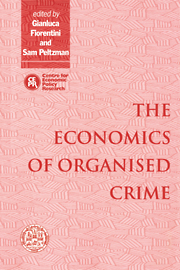Book contents
- Frontmatter
- Contents
- List of figures
- List of tables
- Foreword
- Acknowledgements
- List of conference participants
- 1 Introduction
- PART I THEORIES OF THE STATE AND THE ORIGIN OF CRIMINAL ORGANISATIONS
- PART II THE CRIMINAL ORGANISATION AS A FIRM
- PART III ORGANISED CRIME AND STATE INTERVENTION IN THE ECONOMY
- PART IV DETERRENCE POLICIES AGAINST LEGAL FIRMS INVOLVED IN ILLEGAL ACTIVITIES
- PART V DETERRENCE POLICIES AGAINST ORGANISED CRIME
- 10 Regulating the organised crime sector
- Discussion
- 11 Oligopolistic competition in illegal markets
- Discussion
- Index
11 - Oligopolistic competition in illegal markets
Published online by Cambridge University Press: 04 August 2010
- Frontmatter
- Contents
- List of figures
- List of tables
- Foreword
- Acknowledgements
- List of conference participants
- 1 Introduction
- PART I THEORIES OF THE STATE AND THE ORIGIN OF CRIMINAL ORGANISATIONS
- PART II THE CRIMINAL ORGANISATION AS A FIRM
- PART III ORGANISED CRIME AND STATE INTERVENTION IN THE ECONOMY
- PART IV DETERRENCE POLICIES AGAINST LEGAL FIRMS INVOLVED IN ILLEGAL ACTIVITIES
- PART V DETERRENCE POLICIES AGAINST ORGANISED CRIME
- 10 Regulating the organised crime sector
- Discussion
- 11 Oligopolistic competition in illegal markets
- Discussion
- Index
Summary
Introduction
One of the better-known features of criminal organisations is that they need to invest resources in activities which reduce the effectiveness of deterrence against them. Such activities can take the shape of investments in violence, or the threat of violence, corruption, protection of secrecy and so on. For this reason, in this paper we analyse how different strategies of deterrence affect the interaction between criminal organisations which not only produce an illegal commodity but also invest in anti-deterrence activities in order to reduce the costs of completing transactions in the output market. This interaction between criminal organisations is framed in an oligopolistic market structure because of the growing body of evidence indicating that oligopolistic market structures are prevalent in most core illegal industries such as large-scale drug trafficking, illegal trade in military equipment and money laundering.
Apart from the empirical evidence, we also focus on models of oligopolistic competition for theoretical reasons. Indeed, we do not find convincing the arguments that core illegal industries tend to be either competitive or monopolistic. As for the assumption of monopolistic markets in the core illegal industries, we object to it for the following reasons. First, illegal contracts can be enforced only at relatively high cost and a small scale of activity reduces the risks arising from disputes over contracts. Second, the degree of secrecy needed to manage an illegal organisation implies that agency problems represent a severe constraint on the increase of the scale of operation. Third, the need to build a hierarchical structure for large organisations represents a further risk due to larger information sets at the disposal of some members of the organisation.
- Type
- Chapter
- Information
- The Economics of Organised Crime , pp. 274 - 291Publisher: Cambridge University PressPrint publication year: 1996
- 3
- Cited by

